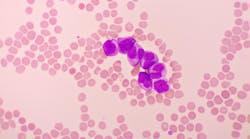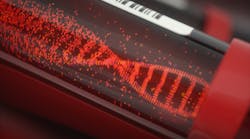Much current research into breast cancer diagnostics and therapeutics has focused on three types of the disease: triple-negative cancer, cancer that is linked to HER2 gene amplification, and cancer that is linked to BRCA gene mutations. Understanding gained from this research is advancing personalized approaches to cancer and improving patient outcomes. Here are accounts of recent studies that could have far-reaching implications.
“Liquid biopsy” IDs patients with new HER2 mutation
There is a group of metastatic breast cancers that has the HER2 gene amplified—that is, the cells have abnormally many copies of it—and this leads to enhanced activity of the product enzyme, a tyrosine kinase. HER2 has been established as a therapeutic target in breast cancer, and breast cancers in which the HER2 gene is not amplified do not, in general, respond to HER2-directed therapeutic approaches.
A few years ago, when the research teams of Dr. Matthew Ellis and others carried out a molecular characterization of breast cancer tumors, they found a new mutation in HER2 that was different from gene amplification but also resulted in tyrosine kinase being constantly activated.
“In this particular activation mechanism, the cells develop a subtle mutation within the functional part of the HER2 gene that activates the enzyme,” says Ellis, professor and director of the Lester and Sue Smith Breast Center, part of the National Cancer Institute-designated Dan L Duncan Comprehensive Cancer Center at Baylor College of Medicine. “The mutation locks the enzyme into an ‘on’ position.”
Ellis and his colleagues developed a preclinical model to study this new HER2 mutation and discovered that the enhanced enzymatic activity could trigger tumor formation. Furthermore, these tumor cells were sensitive to an experimental drug, neratinib. With this information in hand, the researchers took the next step.
“We launched a phase II clinical trial of neratinib in patients with metastatic breast cancer carrying a HER2 mutation,” Ellis says. “Finding patients who are positive for a HER2 mutation required a national collaboration because we had to screen hundreds of patients to identify the two to three percent that have a tumor driven by a HER2 mutation. The results of the clinical trial were encouraging in that about 30 percent of the 16 patients treated with neratinib had a meaningful clinical response showing significant disease stabilization or regression. Neratinib was well tolerated by most patients.”
The number of patients who could potentially benefit from this new treatment approach is estimated to be in the thousands. The researchers estimate that as many as 200,000 patients are likely to be living with metastatic breast cancer today in the United States. Based on the estimate that the new mutation is present in two to three percent of cases, the researchers calculated that approximately 4,000 to 6,000 patients with metastatic breast cancer carry a HER2 mutation and are therefore potential candidates for neratinib treatment.
To identify the patients in this study who carried the new HER2 mutation, the researchers required a biopsy from which they could extract and sequence the genetic material to determine the presence of the HER2 mutation. This task turned out to be a major challenge because for 20 percent to 30 percent of the patients the researchers did not have sufficient material to make the diagnosis.
“To assist in our ability to identify patients with HER2 mutation-positive tumors, we conducted circulating tumor DNA analysis,” Ellis says. “The tumor’s DNA is released into the bloodstream, and we were able to determine the presence of the mutation in blood samples from the patients. Importantly, the circulating tumor DNA results were highly concordant with the tumor sequencing results, and they were much easier to determine. Notably, the blood test was sensitive enough that we could use it as a tool to determine eligibility for the clinical trial.”
In addition to bringing to the table a novel treatment for metastatic breast cancer carrying a HER2 mutation, the researchers have tested the value of the circulating tumor DNA as a disease-monitoring marker.
“A circulating tumor DNA-based blood test also could therefore be potentially used to monitor tumor progression and to determine whether patients are responding or not to treatment after just one month of therapy,” Ellis says.
Source: A new HER2 mutation, a clinical trial and a promising diagnostic tool for metastatic breast cancer. https://www.eurekalert.org/pub_releases/2017-08/bcom-anh080117.php
A new target for triple-negative breast cancer
So-called “triple-negative” breast cancer is a particularly aggressive and difficult-to-treat form. It accounts for only about 10 percent of breast cancer cases, but is responsible for about 25 percent of breast cancer fatalities.
Triple-negative breast cancer earns its name because, unlike other breast cancer subtypes, its cells test negative for estrogen and progesterone receptors, as well as for the HER2 gene. Therefore, it cannot respond to therapies that inhibit cancer-growing signals that come from estrogen, progesterone, and HER2. The only treatment options for triple-negative breast cancer are surgery, radiation therapy, and chemotherapy, each of which causes difficult side effects and rarely leads to remission.
Triple-negative breast cancer is also highly variable from patient to patient and even among tumor cells of a single patient, making it difficult to understand and treat. Other breast cancer subtypes are homogeneous and thus more predictable and treatable.
University of Virginia researchers are working to study this variability and find an end-around method to stop triple-negative breast cancer, by seeking out unknown or little-understood routes toward shutting down uncoordinated growth.
“We’re interested in the variability that’s characteristic of triple-negative breast cancer,” says Kevin Janes, PhD, an associate professor of biomedical engineering. “We believe this variability gives clues to how the cancer arises, and clues to treatment possibilities that would exploit the way the tumors are regulated or misregulated as the cells communicate with each other.
“We’ve developed methods for investigating the variability of these cells, and finding targets worthy of further study, to see how they might be exploited to suppress growth of triple-negative disease. The hope is to eventually create novel medications that could stop this aggressive form of cancer by intervening in its progression, using methods we simply have not tried before. We are working hard to gain fundamental understanding of the processes that promote growth of the variable types of cells in triple-negative breast tumors. What we’re learning may inform, over the long term, the eventual development of new, targeted therapies.”
Janes is the corresponding author of a new study that details a possible way to reengage a tumor suppressor protein—Growth Differentiation Factor 11, or GDF11—that researchers found to be inactivated in triple-negative breast cancer cells. The results of the study, which combines laboratory experiments with bioinformatic analyses, were published recently in the journal Developmental Cell.
“Instead of trying to find and target hormones or genes that might promote growth of these tumor cells, as has been successful for other cancer types, we are focusing on a protein in triple-negative tumor cells that normally should inhibit abnormal cell growth, but has been disengaged,” Janes said.
Janes and his colleagues have found that GDF11 does not mature properly into a bioactive tumor suppressor, as it should normally do, but instead accumulates within cells in a “pre-active” state.
“This is an exciting realization,” Janes says, “because we now can look for ways to remobilize the GDF11 precursor and reengage its normal tumor suppressive activity wherever triple-negative cancer cells reside in the body.
“We’re still early in this investigation, but it may be a step in the right direction for getting a handle on ways to target this very difficult to treat breast cancer subtype.”
Source: UVA researchers discover a new target for ‘triple-negative’ breast cancer. https://www.eurekalert.org/pub_releases/2017-11/uov-urd112017.php
Insights into the mechanisms of BRCA-deficient cancer cells
In a paper recently published in Nature Communications, a team led by Saint Louis University researcher Alessandro Vindigni, PhD, shares new information about how BRCA-deficient cancer cells operate and interact with chemotherapy drugs, and what may be their last-ditch effort to survive. Researchers hope that their findings may lead to improved chemotherapy drugs and shed light on why some cells develop chemotherapy resistance.
Vindigni studies genome integrity, the ability of a cell to faithfully transmit its DNA information on to new cells. As cells create duplicate copies of their genetic material, a lesion or other obstacle can block DNA replication, potentially derailing a cell’s ability to reproduce. Lesions in DNA can occur as often as 100,000 times per cell per day. If a cell’s replication machinery collides with the lesion, a strand break can occur.
When confronted with a lesion, cells have repair strategies, including a tactic called fork reversal. DNA replicates by unzipping its two interwoven strands and making copies of each. As the DNA strands separate and copy, they form a “replication fork.” If these forks run into obstacles like lesions that block their progress, cells perform a maneuver called fork reversal.
Once the damage on the DNA is recognized, DNA replication reverses its course by forming reversed forks. The newly synthesized DNA strands detach from their parental strands and attach to each other. At the same time, the parental strands reconnect, partially zipping up the fork. As a result, the fork transforms into a four-way junction structure, known as a reversed fork. Formation of reversed forks prevents forks from colliding with the replication obstacles, giving time for the damage to be repaired before replication resumes. In previous research, Vindigni and team identified new enzymes that enable cells to resume replication once the DNA lesion has been repaired.
To stop cancer cells, which proliferate by replicating faster than healthy cells, many chemotherapy drugs work by inducing DNA lesions with the hope of blocking replication.
While fork reversal strategies help healthy cells survive, they also allow cancer cells to thrive and withstand DNA damaging chemotherapy. The research of Vindigni’s team provides important clues on enzymes that can be targeted to prevent fork reversal and increase chemotherapy sensitivity.
In the current study, Vindigni examined BRCA-deficient cancer cells. Mutations in the BRCA gene are associated with several forms of cancer, including breast, ovarian and prostate cancers.
The healthy cells of people who have BRCA mutations lack one copy of the BRCA gene. If they develop tumors, however, those cells lack both BRCA copies. Scientists used this distinction to develop chemotherapy drugs that take advantage of this difference. The tumor cells are much more susceptible to DNA- damaging drugs because they lack both copies, whereas healthy cells aren’t as likely to be affected by the same drugs because they retain one good copy of the gene.
BRCA proteins are known for their role in repairing double strand breaks. They also play a part in “sterilizing” replication forks that have stalled by treatment with DNA-damaging agents. A major function of BRCA proteins is to protect these stalled forks and keep them from being degraded. However, the exact structure of the replication forks protected by BRCA proteins remained unknown.
Our nuclei have enzymes called nucleases that can degrade DNA for several thousands of bases. When BRCA proteins are missing, the stalled DNA forks are unprotected and nucleases can easily start chewing up the DNA. This explains why BRCA-deficient tumors are susceptible to chemotherapeutic drugs that stall DNA replication; in the absence of BRCA, DNA is unprotected. The protein MRE11 was the first nuclease found to be effective at this.
“The idea is that if you take a cancer cell line that has a BRCA mutation and take a drug that blocks replication, the forks stall,” Vindigni says. “At that point, the fork is unprotected and so can be degraded by MRE11. This degradation digests the fork, leading to chromosome instability and accumulation of DNA breaks. In the absence of BRCA proteins, these breaks cannot be repaired and the cell won’t survive.
“This explains why patients with BRCA mutations can be treated with chemo drugs that induce DNA damage and replication fork arrest.” Working from this information, Vindigni and the research team wanted to answer three questions: 1) Which other nucleases degrade unprotected DNA? 2) How are these nucleases able to degrade the forks? 3) What ultimately happens to these forks?
“What we found is that our cells have a way of rescuing these stalled and degraded forks,” Vindigni said. “We have a backup mechanism. As a last resort, if DNA is extensively degraded, the cell can cut the DNA and use a specialized mechanism to rescue the degraded forks. It is the last rescue pathway that our cells have to avoid cell death.”
While degraded DNA leads to increased chromosome instability, the researchers found that it is not necessarily terminal. It is possible for cells to cut the strands and rescue the stalled forks to avoid cell death.
What could this mean for cancer treatments?
“Now, we might have a strategy to sensitize even more patients with BRCA-deficiency to chemotherapy drugs,” Vindigni said.
“If you block this last rescue pathway, then you would really be in a scenario where cells lacking BRCA couldn’t survive. Normal cells expressing one copy of the BRCA gene would have a way to repair, and have a functional repair pathway if they do face an obstacle. Cancer cells lacking both copies of the BRCA genes, though, would be massively degraded, and we would block their last recourse.”
Source: SLU researchers discover BRCA cancer cells’ last defense. https://www.eurekalert.org/pub_releases/2017-11/slu-srd112717.php





